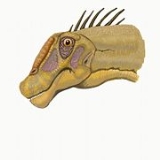
Nemegtosaurus
Encyclopedia
Nemegtosaurus was a sauropod dinosaur
from Late Cretaceous
Period of what is now Mongolia
. It was named after the Nemegt Basin
in the Gobi Desert
, where the remains — a single skull — were found. It may have had a long, sloping head and, like most sauropods, had peg-shaped teeth.
The type species
, Nemegtosaurus mongoliensis, was first described by Nowinski in 1971. A second species, N. pachi, was described by Dong in 1977, but is a nomen dubium
.
Comparisons between the scleral ring
s of Nemegtosaurus and modern birds and reptiles suggest that it may have been cathemeral
, active throughout the day at short intervals.
Dinosaur
Dinosaurs are a diverse group of animals of the clade and superorder Dinosauria. They were the dominant terrestrial vertebrates for over 160 million years, from the late Triassic period until the end of the Cretaceous , when the Cretaceous–Paleogene extinction event led to the extinction of...
from Late Cretaceous
Cretaceous
The Cretaceous , derived from the Latin "creta" , usually abbreviated K for its German translation Kreide , is a geologic period and system from circa to million years ago. In the geologic timescale, the Cretaceous follows the Jurassic period and is followed by the Paleogene period of the...
Period of what is now Mongolia
Mongolia
Mongolia is a landlocked country in East and Central Asia. It is bordered by Russia to the north and China to the south, east and west. Although Mongolia does not share a border with Kazakhstan, its western-most point is only from Kazakhstan's eastern tip. Ulan Bator, the capital and largest...
. It was named after the Nemegt Basin
Nemegt Basin
The Nemegt Basin is situated in the northwestern part of the Gobi Desert, in the Ömnögovi Province in the southern part of Mongolia. It is known locally as the valley of the dragons, since it is a source of many fossil finds, including dinosaurs, dinosaur eggs and trace fossils.The main geological...
in the Gobi Desert
Gobi Desert
The Gobi is a large desert region in Asia. It covers parts of northern and northwestern China, and of southern Mongolia. The desert basins of the Gobi are bounded by the Altai Mountains and the grasslands and steppes of Mongolia on the north, by the Hexi Corridor and Tibetan Plateau to the...
, where the remains — a single skull — were found. It may have had a long, sloping head and, like most sauropods, had peg-shaped teeth.
The type species
Type species
In biological nomenclature, a type species is both a concept and a practical system which is used in the classification and nomenclature of animals and plants. The value of a "type species" lies in the fact that it makes clear what is meant by a particular genus name. A type species is the species...
, Nemegtosaurus mongoliensis, was first described by Nowinski in 1971. A second species, N. pachi, was described by Dong in 1977, but is a nomen dubium
Nomen dubium
In zoological nomenclature, a nomen dubium is a scientific name that is of unknown or doubtful application...
.
Comparisons between the scleral ring
Sclerotic ring
Sclerotic rings are rings of bone found in the eyes of several groups of vertebrate animals, except for mammals and crocodilians. They can be made up of single bones or small bones together. They are believed to have a role in supporting the eye, especially in animals whose eyes are not spherical,...
s of Nemegtosaurus and modern birds and reptiles suggest that it may have been cathemeral
Cathemeral
A cathemeral organism is one that has sporadic and random intervals of activity during the day or night in which food is acquired, socializing with other organisms occurs, and any other activities necessary for livelihood are performed...
, active throughout the day at short intervals.

